Tags
Brigham Young, Church of Jesus Christ of Latter-day Saints, Ed Firmage, Edward W. Tullidge, Eliza R. Snow, George Henry Snell, Godbeite Movement, H. R. Hall & Sons, John Shaffer, John Taylor, Jon Bingham, Kenneth Brailsford, Kingdom of God, Life of Brigham Young; or, Linda Brailsford, Millenial Star, Mormon, pioneers, railroad, Saltair Beach Resort, Slat Lake Valley, Utah, Utah and Her Founders, Utah Central Railroad, Utah Soap Company
Title: Life of Brigham Young; or, Utah and Her Founders
Author: Edward W. Tullidge
Published: New York, (s.n.), 1876
Pages: 458 with 81 additional pages comprising a supplement containing biographical sketches of other prominent Utah leaders (Contains Errata slip: “Biographical sketches of the late Willard Richards, Joseph A. Young, and others, not received by the printer in time for this issue will be inserted in subsequent editions.”)
Bound in ornamental gilt stamped purple cloth. Blind stamped borders; blind stamped title on rear cover; coated end papers.
Signed, presentation copy: “Presented to G. Henry Snell by Brigham Young [signed], Salt Lake City, U.T., October 16th, 1876”
Includes an engraving of Brigham Young by H.R. Hall & Sons (of New York)
A gift from Ed Firmage (University of Utah Professor Emeritus) to the Rare Books Department raises intriguing questions. In the front of this well preserved copy of the Life of Brigham Young; or, Utah and Her Founders, published in 1876, is a calligraphic inscription wherein Brigham Young presents this copy to G. Henry Snell. According to an obituary, George Henry Snell was a successful business man in the Salt Lake City area during the latter half of the 19th century. Born in St. Louis, he moved to the Salt Lake Valley as a young child. Mr. Snell operated the Utah Soap Company and was one of the original stockholders in the Saltair Beach Resort. He suffered from a heart condition that resulted in an early death at fifty years of age. What is not known is the nature of the relationship between Henry Snell and Brigham Young, the then President of the Church of Jesus Christ of Latter-day Saints and, as the memoir shows, one of the most powerful men in the American West at the time.
Written by Edward W. Tullidge, this biography of Brigham Young includes memoirs concerning many of the prominent early LDS church leaders in Utah. Despite evidence Brigham Young was not opposed to this biography (the fact that he presented copies as gifts, as seen above), Tullidge was not sanctioned by the LDS church to write it. The author himself tells us his reasons for undertaking the work in the preface:
“That the matters embodied in the chapters of this book are eminently worthy an enduring record will, I think, be cheerfully conceded. Of myself let me say, if the manner in which I have handled the subject betrays my love for the Mormon people, I confess it. But it must not be forgotten that I have been, for many years, an apostate, and cannot be justly charged with a spirit of Mormon propagandism. Rather have I striven to treat the subject with an artist’s fidelity, and with the earnestness of one concerned.”
So we see that Edward Tullidge wrote his account because of his love for the Mormon people and believed the events of the time period covered in his book were “worthy an enduring record.” But he also divulged he was an apostate, or one who had left the church.
Born in England in 1829 and having been introduced to the Church of Jesus Christ of Latter-day Saints there in the 1840’s, Edward Tullidge immigrated to the Salt Lake valley in the early 1860’s where he became a literary critic, newspaper editor, playwright, and historian. He wrote numerous journal articles, several plays, and five books (including the Life of Brigham Young). Although still technically a member of the LDS Church at the time of writing the biography (despite the claim of being apostate in the preface), Tullidge participated in the Godbeite movement (which initially sought to reform the church by breaking Brigham Young’s hold on secular and economic matters) and then in the late 1870’s joined the Reorganized Church of Jesus Christ of Latter-day Saints.
Some LDS church leaders did not approve of the biography Tullidge wrote about Brigham Young. There is evidence of this in an article published in the Millenial Star in November of 1878. The article relates an interview between President John Taylor and Edward Tullidge concerning his publishing of Life of Brigham Young and his interest in writing a biography on Joseph Smith. During the interview President Taylor inquired about the statement in the biography’s preface concerning him being an apostate and forbade Tullidge from having access to the church’s Historian’s Office.
Life of Brigham Young is a historical treatise dealing primarily with the socio-political developments of the Latter-day Saints from their arrival in the Salt Lake valley in the late 1840’s to the mid 1870’s when the book was published. At publication Brigham Young was seventy-five years old and still the leader of the Church of Jesus Christ of Latter-day Saints, but the book shows many ways in which the federal government and dissidents in the Salt Lake valley had drawn secular power away from him over the previous two decades (1850’s – 1860’s). Tullidge showcased the deep cultural issues of the time with passages such as (page 366-367):
“Governor Shaffer arrived in Utah in the latter end of March, 1870. Casting about for some object on which to expand his belligerency, he made enquiry of a prominent schismatic as to the feasibility of successfully attacking polygamy. The answer was: ‘I married my wives in good faith. They married me in good faith. They have borne me children. We have lived together for years, believing it was the will of God. The same is true of the Mormon people generally. Before I will abandon my wives as concubines, and cast off my children as bastards, I will fight the United States Government down to my boots. What would you do, Governor, in the like case?’
‘By —, I would do the same!’ [the Governor replied.]”
Tullidge also wrote of significant historical events that came to fruition under Brigham Young’s leadership such as (page 362-363):
“The next important event in the history of Utah was the laying of the last rail of the Utah Central Railroad. The completion of the Union and Central Pacific lines was a national event, affecting greatly the destiny of Utah as well as that of the entire Pacific coast; but the completion of the Utah Central was the proper local sign of radical changes. …
It was January 10th, 1870; the weather was cold; a heavy fog hung over the city of the Great Salt Lake; but the multitude assembled, and by two o’clock P.M. there is said to have been gathered around the depot block not less than fifteen thousand people. … A large steel mallet had been prepared for the occasion, made at the blacksmith’s shop of the public works of the Church. The last ‘spike’ was forged of Utah iron, … The mallet was elegantly chased, bearing on the top an engraved bee-hive (the emblem of the State of Deseret), surrounded by the inscription ‘Holiness to the Lord,’ and underneath the bee-hive were the letters U.C.R.R.; a similar ornament consecrated the spike, both intending to symbolize that Utah, with the railroad, should still be the ‘Kingdom of God.’ … The honor of driving the last spike in the first railroad built by the Mormon people, was assigned to President Young.”
The Life of Brigham Young provides a dual perspective of an important time in Utah’s history from an author who loved the Mormon people yet disagreed with some of the policies of the prominent leaders he wrote about. This perspective adds value to the historical record of the two decades following the settling of the Salt Lake Valley by the early Mormon pioneers.
Questions that the Rare Books staff will continue to research include the number of copies printed and how many of those Brigham Young gave (with the front inscription) to others. We know of one other inscribed copy (given to Eliza R. Snow, wife of Brigham Young), which is in the Kenneth and Linda Brailsford manuscript collection (Accn 2935).
Contributed by Jon Bingham, Rare Books Curator

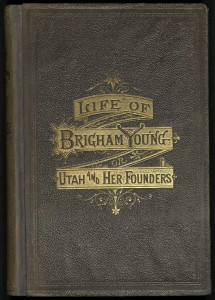
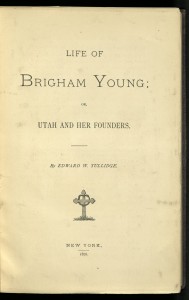
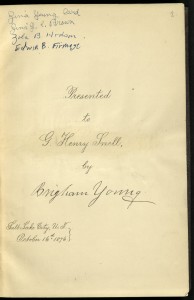
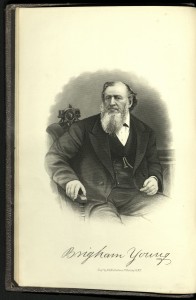
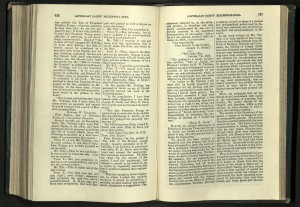
What a wonderful gift!
And thank you, Jon, for an excellent article.
Dave Morrison
Marriott Library
Dave, thank you for taking the time to read it and for the kind words. I hope to continue contributing on a regular basis.